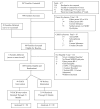Reducing youth internalizing symptoms: effects of a family-based preventive intervention on parental guilt induction and youth cognitive style
- PMID: 24438999
- PMCID: PMC4259150
- DOI: 10.1017/S0954579413001016
Reducing youth internalizing symptoms: effects of a family-based preventive intervention on parental guilt induction and youth cognitive style
Abstract
This study utilized structural equation modeling to examine the associations among parental guilt induction (a form of psychological control), youth cognitive style, and youth internalizing symptoms, with parents and youth participating in a randomized controlled trial of a family-based group cognitive-behavioral preventive intervention targeting families with a history of caregiver depression. The authors present separate models utilizing parent report and youth report of internalizing symptoms. Findings suggest that families in the active condition (family-based group cognitive-behavioral group) relative to the comparison condition showed a significant decline in parent use of guilt induction at the conclusion of the intervention (6 months postbaseline). Furthermore, reductions in parental guilt induction at 6 months were associated with significantly lower levels of youth negative cognitive style at 12 months. Finally, reductions in parental use of guilt induction were associated with lower youth internalizing symptoms 1 year following the conclusion of the intervention (18 months postbaseline).
Figures




References
-
- Abela JRZ, Hankin BL. Cognitive vulnerability to depression in children and adolescents: A developmental psychopathology perspective. In: Abela JRZ, Hankin BL, editors. Handbook of child and adolescent depression. New York: Guilford Press; 2008. pp. 35–78.
-
- Abramson LY, Metalsky GI, Alloy LB. Hopelessness depression: A theory-based subtype of depression. Psychological Review. 1989;96:358–372. doi: 10.1037/0033-295X.96.2.358. - DOI
-
- Achenbach TM, Rescorla LA. Manual for ASEBA schoolage forms and profiles. Burlington, VT: University of Vermont, Research Center for Children, Youth, and Families; 2001.
-
- American Psychiatric Association. Diagnostic and statistical manual of mental disorders. 4. Washington, DC: Author; 2000. text revision.
Publication types
MeSH terms
Grants and funding
LinkOut - more resources
Full Text Sources
Other Literature Sources
Medical

